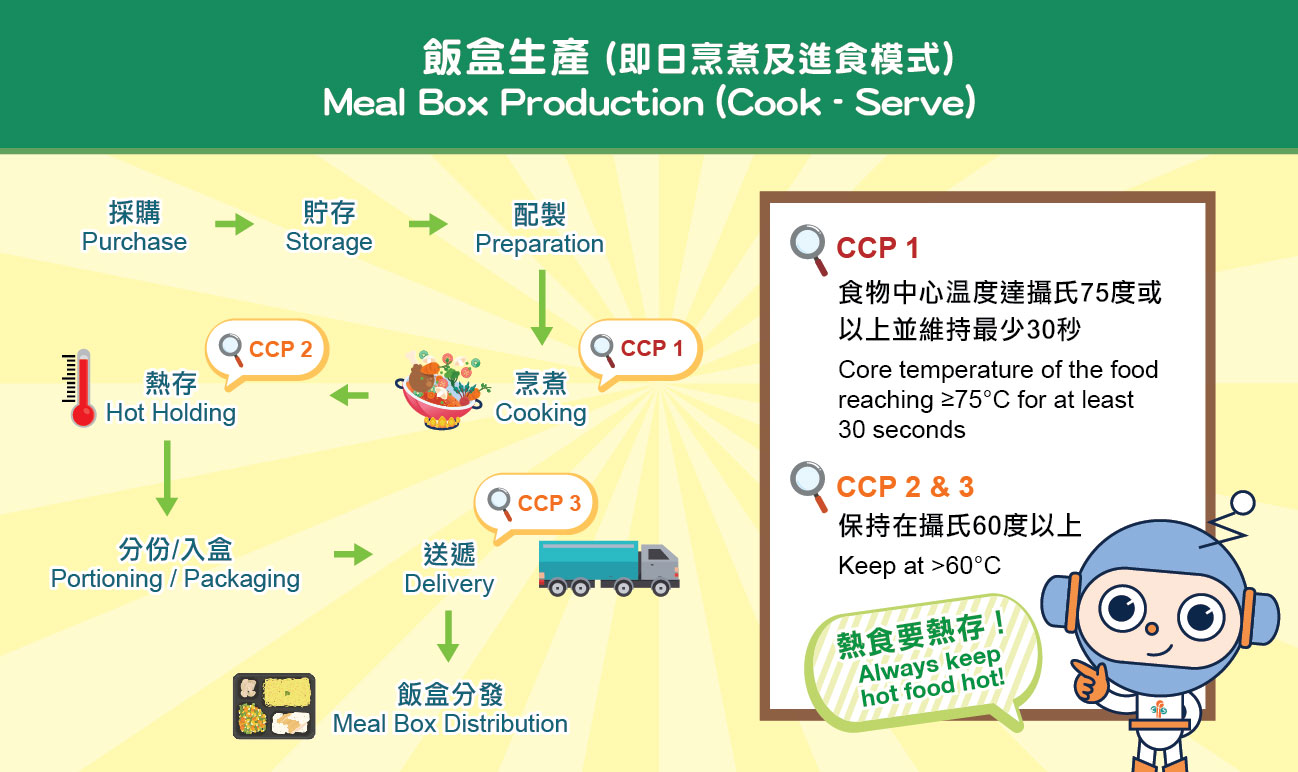
Food Safety Focus (200th Issue, March 2023)–Article 2
School Lunch and Food Safety
Reported by Ms. Rita OSBORN, Chief Health Inspector,
Ms. Amy CHENG, Research Officer,
Risk Communication Section, Centre for Food Safety
Assuring the safety of food served in schools is essential as young children are particularly susceptible to foodborne illness. Inappropriate food handling encourages the spread of pathogens and poses a potential threat to food safety. The collaborative effort of schools, meal box suppliers and parents is necessary to safeguard food safety and the health of students. This article highlights the potential hazards in the course of lunch box preparation.
Food safety of meal boxes from suppliers
Meal boxes are typically mass-produced at the supplier's food factory. Therefore, any lapse in food safety can potentially affect a large number of diners. To ensure food safety of the meal box produced, suppliers should plan ahead of time to ensure sufficient manpower, space and equipment for food storage, preparation, cooking and hot-holding. Kitchens should preferably have designated working zones and different utensils for handling raw and cooked food. Comprehensive operating protocols and cleaning schedules should be in place to ensure the adoption of "5 Keys to Food Safety" and Good Hygiene Practices (GHPs).
Keeping food away from Danger Temperature Zone between 4°C and 60°C is key to producing safe meal boxes. In general, there are three major critical control points (CCPs) along the process of meal box preparation where food safety hazards can be prevented or eliminated:
Cooking
Thorough cooking is a critical step to eliminate pathogens such as Salmonella that are likely to accompany any raw foods brought into a food preparation area. Foods including rice should be thoroughly cooked and reheated until its centre reaches 75°C or above. Where possible, cook all food items, including sauce and soup, on the day of consumption.
Hot holding
Prolonged storage and transport within temperature danger zone after cooking will allow bacteria to grow. Hence, finished meal boxes should be consistently kept at above 60˚C in electric warming trolleys. Hot-holding equipment should be pre-heated by suitable and feasible means before putting meal boxes in it. Schools should distribute the meal boxes to students in a timely manner upon arrival.
Delivery
Controlling the temperature of food (e.g. hot food kept above 60˚C) during delivery is equally important in ensuring that food is safe to eat, likewise the delivery time should be shortened as far as practicable. Insulated containers can be used to keep food consistently hot before use.
CCPs should be monitored to assess whether they are met, such as using a temperature probe to measure food temperature, followed by proper documentation. If the established CCP standards are not fulfilled, corrective actions such as continuing the cooking process until it reaches the target standard should be taken in order to bring the process back into control.

Figure 1: Schematic diagram for meal box production
Meal produced at school canteens
Schools with in-house kitchens should also observe the aforementioned practices when preparing and serving meals. Cross-contamination and lapses during portioning are two major concerns when meals are prepared on campus. The use of the same equipment for handling raw and ready-to-eat foods may result in contamination after cooking. To prevent cross-contamination, food handlers should wash hands regularly, and change gloves between preparing foodstuffs or when soiled. Utensils for different purposes and areas should be clearly labelled. Environmental hygiene of dining areas such as canteens should also be well maintained. It is often best to follow a 'clean as you go' approach while preparing food; trash should be properly disposed of after each meal to avoid pest infestation.
When giving out food to students, it should be done in a designated area with enough space, and staff handling the meals should observe personal hygiene. Portioning utensils and tableware provided to students should be clean and kept in good condition. Hot-holding devices should be available in order to keep meals at a temperature above 60°C.
Precautions when bringing home-made meal boxes
When choosing to pack lunches for their children, parents should keep the "Five Keys to Food Safety" in mind. Pre-cooked food should be thoroughly reheated and kept at safe temperatures by storing them in appropriate insulated containers. Students should wash their hands thoroughly before tucking in. In order to create a safe and healthy environment at school, food handlers should always maintain personal hygiene and have a basic understanding of food hygiene and temperature control, regardless of how the school meals are prepared.


